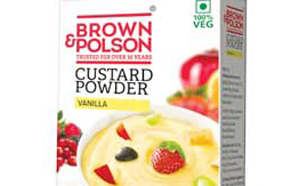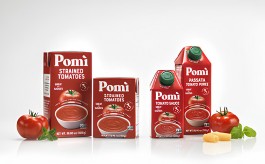HUL dusts off its dessert brands
By Dinesh Jain | Vjmedia Works | February 12, 2015
The largest FMCG player revitalises two of its heritage brands in search of spaces to occupy in the food space
 Hindustan Unilever (HUL) overhauled one of its oldest brands, Brown & Polson, with unmissable outdoor ads. Images of a rich layer of custard covering a bowl of sundae or a cupcake were all across Mumbai last month, including the busiest stations of the Mumbai Metro.
Hindustan Unilever (HUL) overhauled one of its oldest brands, Brown & Polson, with unmissable outdoor ads. Images of a rich layer of custard covering a bowl of sundae or a cupcake were all across Mumbai last month, including the busiest stations of the Mumbai Metro.But the brand at the centre of all this action has been part of HUL's portfolio for the last decade and a half since parent Unilever acquired the US-based Bestfoods (in 2000). So, why the flurry of activity now? The answer lies in the largest FMCG company's ambition of making it in foods, a business where it has had limited success, compared to rivals of comparable size.
The acquisition of Bestfoods also meant that HUL (then HLL) got brands such as Rex Jelly, Knorr Soup, Captain Cook Saltand the vitamin drink Glucovita from its Indian arm, International Bestfoods. This company was ultimately merged with the Indian arm of Unilever.
While the focus of HUL shifted to Knorr Soups, Brown & Polson and Rex Jelly remained in its portfolio. Glucovita was sold to Wipro and Captain Cook phased out soon after the acquisition.
Knorr and another acquired brand Kissan (jams and ketchups), of course, went on to dominate HUL's packaged foods portfolio (the company also has Annapurna in staples and Modern Bread in bakery), giving it nearly 6 per cent of its FY-14 turnover of Rs 28,019 crore.
Besides Brown & Polson, Rex Jelly is also getting a facelift. The "relaunch" of two of its brands, say sector analysts, is intended to help HUL in occupying more spaces, such asdessert powders, where it can make a mark within foods. The rebranding might give HUL a boost in desserts where the two brands play.
"Our strong performance in our larger core (food) categories now allow us the liberty to focus, invest and innovate in the desserts category. We clearly see this as a growth driver and are excited at the potential it presents," says Abhiroop C, general manager, foods, HUL.
This move comes as rivals such as ITC race ahead in foods. Food brands constitute 70 per cent of ITC's non-cigarette FMCG business, which crossed Rs 8,000 crore in FY-14. ITC indicated in this fiscal that it would expand its foods-play by stepping into dairy, functional food, fruit juices, tea, coffee and chocolates soon. Investment in juice, chewing gums and dairy have already been made by the company.
The pressure is on for HUL to fortify its foods business as a result. "Brown & Polson and Rex are strong brands with great heritage. It was important to build on the legacy values and re-invent them to make them more relevant and representative of the modern times," Abhiroop adds.
HUL adopted a multi-pronged approach when refurbishing the two. "We began last year (2014) by getting our trade architecture (distribution) right with respect to these brands. The idea was to make us more competitive in the marketplace. The second part was new packaging for the products. We then ensured we created stunning in-store presence for our brands, especially in the right profile of outlets. We then created films, which were launched online, with the objective of sharply targetting those who were looking for recipe solutions. Lastly, in the cities of Mumbai and Delhi, we chose to use outdoor and print to amplify the advertising message," says Abhiroop.
While HUL did not indicate how many stores saw sales activations, analysts say that as with most packaged food products, Brown & Polson and Rex would be available in all modern trade and general trade outlets.
HUL is intent on carving out a strong niche with Brown & Polson. "In today's day and age, custard has lost some of its "coolness" and "fun" that one would associate with it earlier. The idea of "Bring custard back", ie. the campaign we launched for the revitalisation, was intended to help bring the product's cool quotient back. We also wanted to show the versatility of custard and how it could combine with desserts commonly consumed in India," says Abhiroop.
The relaunches of brands that were relatively sedate till now will also drive the usage of the categories of custard and jelly (gelatin) powder, thereby, improving the fate of these two brands, feel FMCG analysts.
The history of Brown & Polson
Brown and Polson was a firm that produced starch for shawl-makers in the 19th century in the UK.
However, it is best known for producing an edible starch out of maize that became the base for custard in 1854.
This product was hailed as a breakthrough in the 19th century, making Brown & Polson Custard popular throughout the UK.
In 1936, Brown & Polson was acquired by the American major Corn Products Refining Company. This gave Brown & Polson a larger footprint beyond its British market.
Corn Products Refining and another American company Bestfoods merged in 1959 to become Corn Products Company. Brown & Polson became more widely available as a result of this move. Corn Products Company became CPC International in 1969 only to revert to the name Bestfoods in 1998.
Two years later, Unilever acquired Bestfoods. While the Anglo-Dutch major sold Brown & Polson to UK's Premier Foods in 2003, the deal excluded India.








